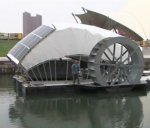Baltimore’s Inner Harbor trash problem is being addressed in part by the Inner Harbor Water Wheel – a solar and hydro powered garbage collector.
Constructed by Clearwater Mills, the contraption is moored at the mouth of Jones Falls. Runoff from city and county streets carries litter to Jones Falls and downstream to the harbor. At times the debris can be so heavy that Jones Falls is covered from shore to shore with floating garbage.
The trash collecting device uses an “undercut” waterwheel to power a ladder type conveyor. Booms shepherd the rubbish towards this and the garbage is lifted by the conveyor and then deposited in a dumpster on a separate barge. Marine operation crews manoeuvre the dumpster platform to a ramp where the dumpster is picked up and emptied by a truck.
The Inner Harbour Water Wheel is covered by a material structure to prevent trash from being blown away and to improve the general aesthetics of the rig.
While the Water Wheel is primarily powered by water current; if the flow of the river is insufficient an auxiliary pump will be utilised. This pump is powered by deep cycle batteries charged by solar panels affixed to the covering structure. The pump is also used to wash down equipment.
In addition to removing what is quite an eyesore, the Water Wheel also helps oxygenate the water and also removes organic debris that can generate compounds toxic to marine life as it decomposes.
The Inner Harbor Water Wheel is able to collect more than 22 tonnes of floating garbage a day and will play an important role in the City’s goal to make the Inner Harbor swimmable by 2020. The latest Water Wheel builds on the functionality of a pilot project device that collected over 50 tonnes of trash during trials.













































